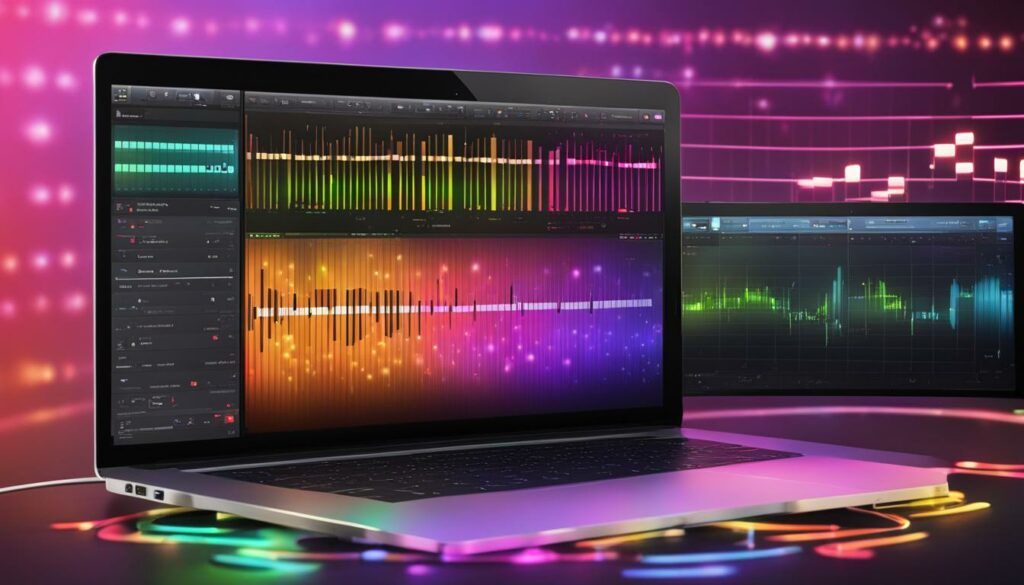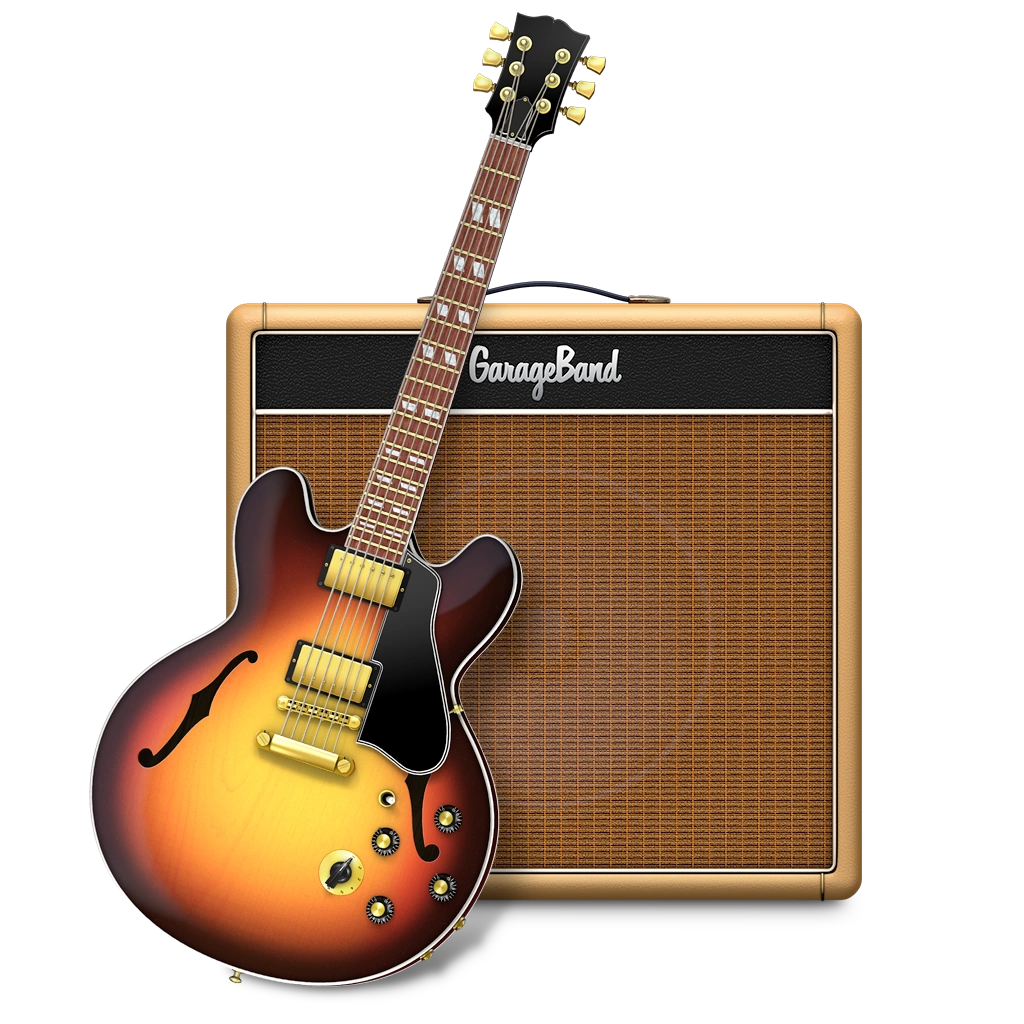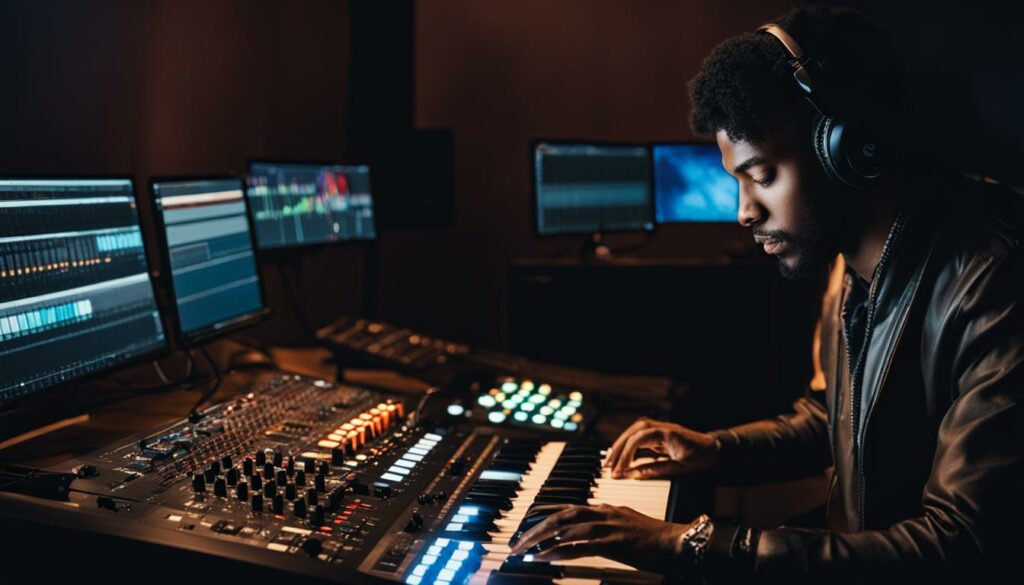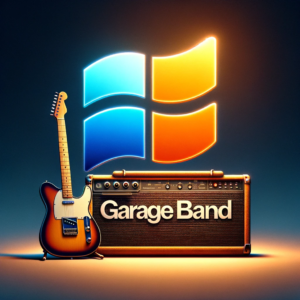As digital music creators, we often explore the vast realm of audio manipulation, and how to loop in GarageBand stands as a cornerstone in our creative toolbox. Seamlessly creating loops in GarageBand enhances our tracks, allowing us to extend captivating melodies or rhythms for as long as our composition demands. The ease with which one can initiate loop recording in GarageBand is nothing short of remarkable, laying a foundation for both aspiring and seasoned musicians to innovate endlessly.
Delving deeper into the world of GarageBand looping techniques, we find that the application not only aids in molding the structure of our music but also in injecting life and continuity into our compositions. The ability to manipulate time within our projects—replicating regions to underscore a beat or to construct a backdrop for intricate overlays—is a testament to the power of digital music production.
Join us as we articulate the simplicity and sophistication of looping, ensuring that every cycle of sound is a brick in the edifice of your musical narrative. Whether looking to create a ground-shaking beat or a delicate harmonic pattern, the loop feature within GarageBand ensures that your digital composition is limited only by imagination.
Introduction to GarageBand Looping Techniques
For those of us stepping into the exciting world of music creation, the GarageBand loop tutorial we’ve compiled is an invaluable resource. Whether you’re just starting out or looking to refine your skills, you’ll find that looping in GarageBand for beginners is an essential technique that can significantly enhance your musical projects.
Using loops in GarageBand invites a level of creativity and depth that is easily accessible. From the foundational steps of selecting the perfect Apple Loops to the intricacies of crafting your unique loops and applying captivating GarageBand loop effects, we guide you through each process with clarity and insight.
As we explore these techniques together, you’ll discover not only the versatility they offer but also the boundless creative potential they unlock. Whether your objective is to create addictive beats, atmospheric layers, or innovative soundscapes, our tutorial serves as your compass in the diverse possibilities of GarageBand loop effects and loop creation.
Join us as we delve into these looping concepts, all designed to empower you in your journey from fledgling tracks to polished masterpieces. The loop feature in GarageBand is a tool of incredible power at your fingertips, ready to elevate your music to new heights. Let’s begin this symphony of loops!
The Basics of Looping in GarageBand
For us seeking to master the art of music production, understanding how to loop in GarageBand is a fundamental skill. Let’s examine the core concepts of the GarageBand loop functionality and share some essential GarageBand loop tips for getting started. We will guide you through creating your first loop with ease, equipping you with the know-how to shape your musical pieces with precision.
Understanding GarageBand’s Loop Functionality
As we dive into GarageBand, we notice that its looping feature is ingeniously designed for simplicity and effectiveness. By dragging the upper-right edge of any audio region, we invoke the Loop pointer. This specialized tool allows us to extend the region seamlessly, with handy notches appearing to indicate each loop’s start and end points. It’s an intuitive visual assist that ensures we manipulate our music segments with confidence.
Creating Your First Loop in GarageBand
No musical journey in GarageBand is complete without creating loops in GarageBand. To craft your inaugural loop, all you need to do is control-click on the chosen region and select ‘Loop On/Off’ from the shortcut menu. This simple action triggers an uninterrupted playback loop that persists until the project ends. Want to undo the loop? A repeat of the same action will suffice, making the process reversible and experimentation-friendly.
Armed with this knowledge, we’ve set the stage for you to start your own looping adventures. Stay tuned for deeper insights and advanced techniques as we continue our exploration of GarageBand’s powerful suite of features in our comprehensive GarageBand loop tutorial.
Finding the Perfect Apple Loops for Your Project
When we talk about how to loop in GarageBand, a versatile tool that always comes to mind is the Loop Browser. This feature offers an extensive selection of Apple Loops, integral for enriching any track with rhythmic vitality or melodic charm. These loops are intelligently crafted to not just lay a foundation for our tracks but to dynamically evolve with our project’s tempo or key changes.
As we embark on a journey to discover the ideal loops, using loops in GarageBand becomes a straightforward endeavor. We navigate through the Loop Browser using a bevy of searching methods, identifying sounds by instruments, genres, or even specific descriptors. This precise filtration ensures that we zero in on loops that resonate perfectly with our creative intent.
Favoriting loops is akin to earmarking pages in a playbook. By marking the loops we frequently use or are fond of, we establish an efficient workflow. With categorized favorites, we can swiftly revisit the loops that strike a chord in our sonic explorations, ensuring that our creative process remains uninterrupted.
Our foray into finding the right Apple Loops is more than just a search; it’s about crafting a soundscape that tells a story, the way we envision it. These loops are the building blocks of that narrative, and GarageBand’s Loop Browser is the treasure trove we sift through, selecting with precision, the sonic gems that elevate our musical projects.
Extending and Customizing Loops in GarageBand

Embarking on musical adventures within GarageBand offers us an array of creative prospects, especially when it comes to extending loops in GarageBand. Our capacity to modify the loop length is central to ensuring our music’s rhythm and melody are on point with our compositional vision. This task becomes straightforward when you align the right edge of a loop with a distinct endpoint on the track, allowing the loop to encompass just the right amount of musical time.
Adjusting Loop Length to Fit Your Musical Composition
As we finetune our tunes, one significant aspect is the customizing loops in GarageBand feature. This potent tool assists us in crafting loops that are not only harmonious but also impeccably timed. When new sections of our song come to life, extending the loops is a cinch, enabling the seamless growth of our evolving track. We discover that these loops are not just a monotonous structure but offer a canvas on which the durations and sections are calibrated by our creative choices.
Including Silence and Other Effects Within Loops
In the realm of GarageBand loop effects, we uncover the subtle art of incorporating silence into our loops. By purposefully resizing and lengthening regions, we can infuse stretches of silence, which enrich our tracks with a profound auditory texture and complexity that speaks volumes in the spaces between the sounds. These techniques demonstrate that GarageBand looping techniques are about more than continuity; they are about sculpting the audio space and tailoring it to our narrative desires with each repeated segment.
Equipped with these GarageBand loop tips, we’re prepared to reach new zeniths in our musical production endeavors. Each loop we manipulate beckons us to push boundaries, explore possibilities, and redefine the soundscape with each iteration. Pioneering through GarageBand, we meld technical prowess with artistic insight, shaping loops that resonate with our unique creative pulse.
Loop Recording in GarageBand for Dynamic Tracks
When we immerse ourselves in the creative world of music production, the goal is always to create something that resonates with energy and life. Loop recording in GarageBand serves as a key technique for us to craft these vibrant, dynamic tracks in GarageBand. This method is more than pushing a button; it’s a form of art that enables us, the artists, to layer sounds and harmonies, building depth as we go along.
For those not yet familiar, loop recording involves capturing repeated performances over a pre-defined segment of time or musical measures, enabling us to experiment with various takes and ideas. Each time we circle back to the start of the loop, we have the chance to add something new, to enhance the track incrementally. It’s like painting with sound, adding stroke by stroke to complete a sonic masterpiece.
The beauty of creating loops in GarageBand rests in its simplicity and the seamless integration with the rest of our production workflow. With loop recording, we invite variations and overtones that might not emerge in a single take, giving our music a textured, richer feel. This technique is particularly useful when we’re trying to flesh out a melody or lay down a complex rhythm section that requires exactly the right groove.
As we refine our tracks, our reflections on timing, pace, and transition are crucial. Loop recording gives us the latitude to tinker with these elements in real-time. By overlaying multiple takes, we gather a wealth of material to choose from, finding those magical moments that elevate our music from good to transcendent. The result is often a dynamic track that pulses with the energy and feel of live playing, but with the pristine quality of a studio recording.
GarageBand’s suite of tools accommodates this process ideally, allowing us to loop record with ease and focus on the creative flow. We can effortlessly blend, edit, and arrange these layers, taking control of the final output. We’re not just looping; we’re orchestrating an immersive experience for our listeners, ensuring that with each loop, they’re drawn deeper into the fabric of our musical narrative.
In the pursuit of creative expression, let’s continue to harness the strengths of GarageBand—transforming our initial loops into complex, dynamic tracks that unfold with each listen. Through loop recording, we’re not just producing music; we’re cultivating an ecosystem that breathes and evolves with our artistic impulses.
Organizing and Managing Your Favorite Loops

For us who thrive in the realm of GarageBand, understanding how to loop in GarageBand is only the beginning. An equally important facet of music production is saving loops in GarageBand for efficient reuse. The software offers a cleverly organized approach for managing loops in GarageBand, allowing us to swiftly access our most treasured loops and boost our productive momentum.
How to Save and Access Loops Quickly
The process of saving our favorite loops is designed to be as intuitive as laying down a groove. Marking a loop as a favorite in the Loop Browser imprints our seal of preference, creating a personalized library ready for action. With just a tap, we can tag the loops that resonate with our creative spirit, carving out a toolkit that’s uniquely ours.
We also admire the streamlined capability GarageBand offers through its iOS interface. Exporting and saving loops in GarageBand is a painless affair, with the option to share and save loops in high-quality uncompressed AIFF format. By depositing our chosen loops into the GarageBand File Transfer folder, we ensure that our collection is primed for retrieval, making the creative flow as uninterrupted as the loops themselves.
Our commitment to efficiency in our musical workflow compels us to embrace these organizational features with enthusiasm. By mastering how to loop in GarageBand along with effectively managing loops in GarageBand, we ensure that the backbone of our tracks—the loops—are always at our beck and call, ready to infuse our projects with rhythmic life.
Looping in GarageBand on iOS Devices
For us devoted to the art of music production, navigating GarageBand for iOS presents an exhilarating realm of possibilities, particularly in the sphere of looping. Our exploration into how to loop in GarageBand unveils a user-friendly interface brimming with accessible looping techniques for iOS, allowing us to mold our musical vision with just a few taps on our screen.
We discover the joy of creating music on the go as GarageBand for iOS simplifies the looping process. A light tap on the track region unfurls an editor menu; here, selecting the ‘Loop’ option effortlessly extends the loop to the end of our canvas. This intuitiveness enhances our workflow, making the extension of melodies and rhythms a hassle-free experience.
Adding song sections in GarageBand for iOS is a breeze, allowing us to extend loops beyond the original confines of our project. Whether laying down a base for further improvisation or structuring the groundwork for a full composition, these looping techniques for iOS offer versatility and ease at every step. As we master how to loop in Garageband on our portable devices, we embrace the freedom to create intricate musical pieces, anytime, anywhere.
Advanced Looping Techniques for Seasoned Users
As creators who strive for excellence in music production, we continuously seek ways to push the boundaries of our craft. By embracing advanced GarageBand looping techniques, we have at our disposal a veritable palette with which to color our compositions. The depth of GarageBand’s functionality reveals itself as we delve into these sophisticated methods, unlocking new dimensions in our music.
Utilizing GarageBand’s Loop Effects to Enhance Your Sound
Within the sleek interface of GarageBand, lie powerful GarageBand loop effects that can revolutionize our auditory landscape. It’s not merely about extending a beat or a bar; it’s about enhancing sound with loops to create an immersive, complex soundscape that captivates the listener. By skillfully applying and manipulating these effects, we can transform a simple melody into a rich, textured auditory experience.
Our exploration into the advanced settings reveals a multitude of effect options. Reverb frosts our loops with a cool, distant echo, while distortion injects a gritty, raw energy into our beats. Filters sweep across our audio spectrum, cutting or boosting frequencies to mold the sound to our desire. Even the simplest loops gain depth and dynamism, echoing our intent with greater clarity.
True mastery in GarageBand loop effects is about experimentation, pushing loops beyond their conventional use. As we stretch and compress, apply echoes, or layer multiple effects, we’re not just looping; we’re carving out our signature. Every adjustment, no matter how minute, feeds into the uniqueness of our creation—the loops becoming sonic brushstrokes in our ever-evolving musical canvas.
We encourage our fellow musicians to not shy away from this exploratory phase. With each twist and tweak of GarageBand’s knobs and sliders, we find ourselves in a laboratory of sound, inventing loops that transcend genres and defy expectations. As we continue honing our advanced GarageBand looping techniques, we not only refine our music—we redefine the very essence of what our music can become.
GarageBand Tutorials: Looping Without Limits
As we venture into the vast potential of music creation, achieving mastery over looping techniques is essential. While GarageBand is intrinsically associated with Apple’s ecosystem, the curiosity about GarageBand for Windows PC persists. It’s a testament to the software’s allure that even Windows users seek the harmonious experience it offers. Fortunately, official GarageBand tutorials have thrown a lifeline to those outside the macOS realm.
Utilizing loops in GarageBand emboldens us to transcend traditional musical boundaries, and these principles don’t change across platforms. The good news for Windows enthusiasts is that accessing GarageBand for Windows without emulators is now a reality, as official resources provide a gateway to download GarageBand straight onto a Windows PC. Us Windows users no longer need to wade through cumbersome virtual machines or emulators.
These developments are more than mere convenience; they symbolize an invitation to a broader audience to engage with GarageBand’s looping techniques. As we dabble with the prospect of syncing loops or splicing melodies, the wealth of possibilities GarageBand offers is now unfurled to music aficionados on an additional operating system. Together, let us revel in the expansion of our musical lexicon, grateful that the rich tapestry of GarageBand’s features is accessible across more creative workspaces.
FAQ
How do I loop in GarageBand?
To loop in GarageBand, hover over the upper-right edge of the audio region you wish to loop until you see the loop pointer (a circular arrow icon). Click and drag to the right to extend the loop for as many bars as you need.
What are some basic GarageBand looping techniques for beginners?
Some basic looping techniques include using Apple Loops from the Loop Browser, creating your own loops by adjusting the lengths of audio regions, and adding loop effects for variety. Beginners can easily start by dragging an Apple Loop into their project and repeating it across the track.
Can you create your own loops in GarageBand?
Yes, you can create your own loops in GarageBand. Record or import the audio you want to loop, then adjust the regions and use the looping functionality to repeat it throughout your track as desired.
What is loop recording in GarageBand?
Loop recording in GarageBand allows you to record multiple takes over a specific section of your song. You play through the section multiple times, and GarageBand captures each take, enabling you to choose the best one or combine them.
How do I use Apple Loops in my GarageBand project?
To use Apple Loops in your project, open the Loop Browser by clicking the loop icon in the top right corner. Search or browse to find a loop you like, then click and drag it into your project timeline. The loop will automatically align with your project’s key and tempo.
How can I extend and customize loops in GarageBand?
To extend a loop, drag the loop’s upper-right edge to the desired endpoint. You can customize your loop by cutting, copying, and pasting parts of the region, or by applying effects and adjusting parameters like volume and panning.
Is it possible to include silence within loops in GarageBand?
Yes, it’s possible to include silences within loops by resizing the regions to create gaps or by using the automation features to reduce volume where silence is desired.
How do I save my favorite loops for quick access in GarageBand?
You can save your favorite loops by using the ‘Add to Favorites’ option in the Loop Browser. This tags the loop with a heart icon, making it quickly accessible in your ‘Favorites’ folder.
Are there specific looping techniques for GarageBand on iOS devices?
On iOS devices, you can loop by selecting a region, tapping it, and choosing ‘Loop’ from the pop-up menu. You can also elongate a loop by dragging the end of the region to cover the desired number of bars.
What are some advanced looping techniques in GarageBand?
Advanced techniques include manipulating loop effects like echo and reverb, altering pitch and speed without affecting the loop’s timing, and using automation to create dynamic changes within the looped segments.
Can I access official GarageBand features on a Windows PC?
GarageBand is an Apple product designed specifically for macOS and iOS. However, some unofficial methods might allow you to run GarageBand on a Windows PC, but these are not supported by Apple.
Is there a way to use GarageBand on Windows without using an emulator?
Officially, no. GarageBand is developed exclusively for Apple devices. For Windows users, using an emulator or similar workaround is typically the only option to access GarageBand, which might not provide the full functionality as on macOS or iOS.


